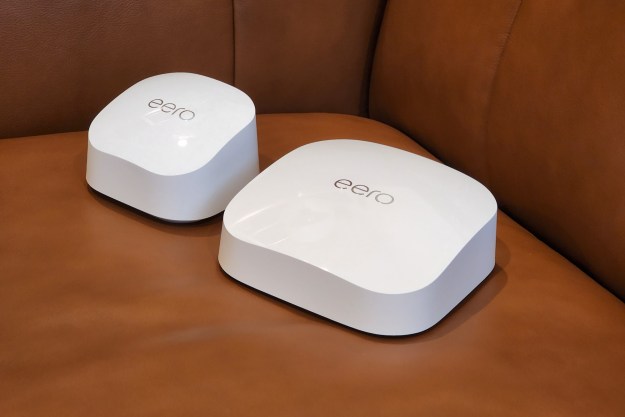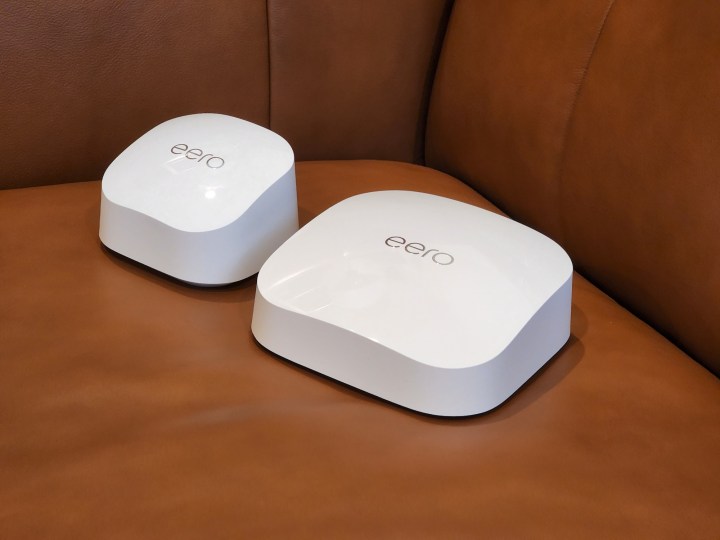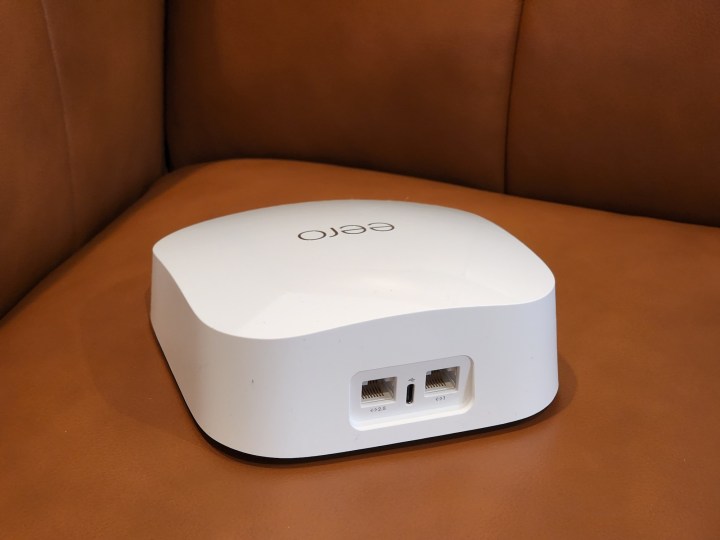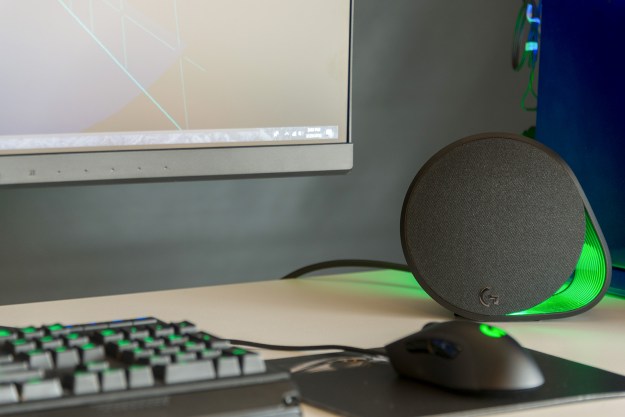
“The Eero Pro 6E is a pro-worthy mesh Wi-Fi router at a far more affordable price.”
- Supports fast, multigig connectivity
- Wi-Fi 6E onboard
- Easy to use and setup
- Great range
- Relatively affordable compared to competitors
- No quad-band design
- Late to the Wi-Fi 6E game
The majority of Americans are still stuck on home internet speeds well under 400Mbps. But if you’re one of the fortunate who have access to a faster broadband or multigig plan, you need a router that can keep up.
That’s where Eero hopes its Pro 6E can step in. Eero’s home mesh networks have been lauded for their minimalist design, ease of use, and simple setups — but now we’ve finally hit the Wi-Fi 6E era. The $299 Eero Pro 6E brings along some pro features at an affordable price, making it an incredible option for those who need the best possible at-home wireless connectivity.
Design

When it launched in 2016, Eero carved out a name for itself for not only being the first to launch a consumer Wi-Fi system with the original Eero, but also for making reliable and robust Wi-Fi coverage accessible for everyday users. Eero routers were unique in that they were compact and attractive, and they were notable in that they lacked the unsightly antennas that are a hallmark of traditional routers, which often were hidden in homes.
The company proved that out of sight and out of mind is a philosophy that no longer works — the attractive design of the mesh routers means that you no longer have to hide your Wi-Fi router, and as these mesh nodes weren’t being concealed, the added advantage is that they can carry your Wi-Fi signals better. Instead, the approachable, glossy white squircle-shaped puck means you can place Eero’s nodes throughout the home, and they’ll likely blend in with your existing decor without seeming out of place.

Coupled with an easy-to-use app to set up, manage, and update its routers, Eero’s new “in sight and out of mind” approach to router design made it a hit with early adopters. It also spawned a slew of competitors, with traditional router manufacturers – Netgear, Asus, TP-Link, and Linksys – joining newcomers like Samsung and Google in the mesh space. And with firmware updates installed automatically overnight, you really don’t need to do much to manage your router.
With the Eero Pro 6E and Eero 6+, Eero retained the designs of these models’ immediate predecessors. The Eero Pro 6E, for example, resembles the existing Eero Pro 6 in the lineup, and the Eero 6+ has a more compact footprint and slightly taller, wedge-shaped stature that matches the design of the Eero 6. There are subtle differences between the new models and the existing Wi-Fi 6-equipped routers in the company’s lineup.
The Eero Pro 6E, for example, has a slightly larger 5.5-inch square base, compared with 5.3-inch square base of the Pro 6, and the newer addition grows 0.3 inches in height to 2.1-inches tall. The Eero 6+ maintains the same 3.8-inch square base as its immediate predecessor, but is 0.2 inches taller at 2.6 inches in height.

Both the Eero Pro 6E and Eero 6+ come with two Ethernet ports on the rear. The Eero Pro 6E comes with a 2.5GbE port and a single 1.0GbE Ethernet port, while the Eero 6+ comes with dual 1.0 GbE ports for wired gigabit connectivity.
In terms of the lineup, the standard Eero remains the entry-level model with Wi-Fi 5 support. Stepping up to Wi-Fi 6 coverage, you can now choose between the Eero 6, the Eero 6+ and the Eero Pro. And the premium flagship Eero Pro 6E comes with more advanced Wi-Fi 6E support.
All of Eero’s Wi-Fi 6 and Wi-Fi 6E routers come with built-in Zigbee support, making it easy to connect smart home devices to the routers directly without requiring an additional hub. Thread and Matter support are also on board for a smarter smart home that doesn’t require a bunch of hubs and bridges scattered throughout the house.
Specs and features

Like all mesh networks, Eero’s routers come with a base unit that plugs into directly into the router, along with nodes that you place around your home to repeat and augment your Wi-Fi signals for better reception throughout the house. The company said its Eero Pro 6E router alone can cover a home up to 2,000 square feet, while a three-pack with two satellite nodes can blanket a 6,000 square-foot home with reliable Wi-Fi signals. The more affordable Eero 6+ router can cover 1,500 square feet, while a three-pack with two additional nodes can cover a home up to 4,500 square feet.
Wi-Fi signal and reception can be greatly affected by your home’s layout, the materials used in the construction, and interference with nearby devices. For example, if your home is constructed with thick concrete or brick walls, you may find that the Wi-Fi signal broadcasted from your router to be weaker, resulting in slower speeds, higher latency, or unreliable coverage. With Eero’s mesh network, you can add nodes to fix drop-offs in Wi-Fi signal as you travel through the home.

Both new Eero mesh systems are available at launch in a two-pack or three-pack, and parent company Amazon will also be making a one-pack available soon for smaller dwellings. An improvement this year compared to the original Eero system is that the multipack designs of the latest models come with three complete routers, whereas the original Eero system shipped with a single router and satellite beacons that had a different, more compact design.
This makes any unit of the Eero 6+ and Eero Pro 6E interchangeable — any of the models in the multi-pack can connect to the router, and each unit comes with two Ethernet ports on the rear for quick access to the wired gigabit connectivity. This makes the design of the latest Eero more in line with competitor Linksys and its Velop and Atlas systems.
This new configuration means you’ll have access to a total of six Ethernet ports.
The change in multipack design shows that Eero is catering to pro users who also need to connect to wired Ethernet ports in remote rooms. If you get a three-pack of the Eero Pro 6E or Eero 6+, this new configuration means you’ll have access to a total of six Ethernet ports throughout your home for a versatile setup that will be beneficial to gamers and streamers. Now, you can have your router in the living room and connect a game console in the office with a wired Ethernet cable for lag-free performance.
The more advanced Eero Pro 6E uses a triband design with a 6GHz lane for faster traffic and reduced congestion. Up to 100 devices can connect simultaneously. Eero claims that multi-gigabit home broadband plans can be supported, and Eero Pro 6E can handle speeds up to 2.3Gbps , with one gigabit over wired and 1.3Gbps over wireless. The standard Eero Pro 6, for example, can only support speeds up to a gigabit.
The Eero 6+ utilizes a dual-band design and can handle broadband plans up to a gigabit. A maximum of 75 devices can be connected simultaneously on this model.
Parental controls

Given that Amazon is positioning Eero as the center of the smarter home, it would have been nice if family-centric features were more accessible. Unlike rival TP-Link, which bundles the cost of parental controls into the price of the hardware, Eero charges an extra subscription for these features. Eero Secure, which costs $3 per month or $30 when billed annually, will allow parents to create profiles for their household, apply filters to block adult-oriented websites on a profile basis, and use the Eero ad blocker to block ads when browsing on any device connected to the home network.
A more premium Eero Secure Plus plan adds access to malware protection, VPN, and the 1Password password manager to the basic plan for a cost of $10 per month or $99 annually.
Setup

Eero prides itself for its simple to set up and easy to manage experience, and the Eero 6+ and Eero Pro 6E continue that tradition. To get started, you’ll want to download and install the Eero mobile app on any iPhone or Android smartphone or an iPad or Android tablet. After you create an Eero account and log in, the app will help guide you through the setup process and tell you when to connect the Eero router to your modem and power. The app provides clear and concise instructions, with suggestions on where to place your nodes. In general, most standard homes will require just one or two nodes, and larger homes can benefit from having three or more nodes scattered across the property.
Each node will need to be connected separately and configured through the app, and the app setup process allows you to give each node a location – like living room, bedroom, kitchen. You’ll also be able to give your network a name – the SSID of your choosing – along with a password. The app will notify you with a push notification every time a new device joins the network to help you keep your home Wi-Fi secure.

And since Eero is now an Amazon product, it can also connect with other Alexa-enabled devices on your network, like smart speakers. If you want to turn off the Wi-Fi, you can do that with a voice command.
The entire process is very simple, and is far less intimidating than trying to access a web-based portal on older routers from a decade ago. Eero will allow you to add more nodes to the router, mix and match nodes from other Eero models, or even add beacons if you need more coverage throughout your home.
You’ll also be presented with an option to set up a guest network for added privacy and security when you have visitors. The app can be used to manage and update the hardware. Like a modern smartphone or tablet, Eero makes firmware and security updates available periodically to add new features or patch existing flaws on the devices.
Performance

To test the Eero Pro 6E, I had set up the network in a friend’s 3,400-square-foot split-level home with a detached garage serving as an office. Thicker metal exterior doors and a brick garage are the biggest obstacles for wireless reception in the space. The $699 Eero Pro 6E review unit we were sent from Amazon contained three nodes – the main node was set up centrally downstairs in the living room and connected directly to the 1Gbps modem via wires, a second node was placed in the far bedroom upstairs, and the third node was placed in the garage to help with signal penetration.
The Eero Pro 6E is also available in a two-pack for $499 and a single pack for $299.
In the living room, the Eero Pro 6E clocked in at over 950Mbps on a Wi-Fi 6E-enabled laptop, and a speed test on a Samsung Galaxy S22 Ultra smartphone with the same Wi-Fi 6E technology notched 946Mbps, showing that the router is capable of delivering on its speed promise.
Prior to installing the second node in the upstairs bedroom, the Samsung Galaxy S22 Ultra was able to get speeds of 780Mbps when connected to the main Eero Pro 6E node from the living room, a degradation of 17.5% in speed. When the upstairs node was connected to the mesh network, speeds upstairs in the furthest corners of the home improved to 837Mbps, or a slowdown of 11.5% compared to the 946Mbps speeds achieved downstairs.
Its main competitor costs more than twice the Eero unit.
This shows that the Eero Pro 6E has great range, and the system should be able to maintain strong speeds even across larger homes. In the garage, when the smartphone was connected to the Eero Pro 6E network via the third node, speeds were in the low 700Mbps range. Because of the construction of the garage, the speed drop of 26% and increase in latency is not unexpected here, and the performance is significantly better than when the home was wired with a traditional Wi-Fi router, as devices in the garage were never able to reliably connect online.
Across all our test zones, performance of the Eero Pro 6E was generally a little bit worse than the competing Netgear Orbi RBKE963 router, a system that benefits from a quad-band Wi-Fi 6E design, albeit at a cost of $1,499 for a three-pack unit. And even though speed degradation across longer ranges was less severe than the Eero Pro 6E, the Netgear Orbi RBKE963 costs more than twice the Eero unit and each node of the Orbi is much larger than the compact Eero.
In my stress test of the system, I had attempted to maintain six 4K video streams on four 4K TVs and two tablets, conduct two simultaneous video calls – one with Microsoft Teams and the other with Zoom conferencing software – play a Sony PlayStation 5 game, and download a large PC game file on a desktop upstairs without any hiccups. Gamers connecting off of the satellites can also plug into the Ethernet port on the Eero Pro 6E for a more reliable connection, which is a nice feature, especially if the main router is located in another location in the home.
Unlike many of its competitors, Eero doesn’t explicitly have labeled support for QoS, which stands for quality of service, in its app. The feature that essentially helps prioritize certain traffic – like gaming or videoconferencing applications – is notably missing from the Eero Pro 6E.
Instead, Eero hid the QoS functionality in the experimental Eero Labs section of the company’s mobile app. In the Labs section, you can toggle the feature to “optimize for conferencing and gaming” traffic to enable Eero’s version of QoS. The company’s feature performs the same task under a different name, and Eero claims that the “additional Wi-Fi bandwidth of 160 MHz radio channels” helps give high bandwidth apps – like augmented and virtual reality applications, gaming, and videoconferencing – the speeds they need.

With the Eero 6+, I tested the unit in my 1,300-square-foot split-level townhouse with an attached garage, since the 6+ model covers a smaller space than the Pro 6E. Unlike the Pro models in Eero’s lineup, the Eero 6+ comes with a dual-band design, and new to the model is access to the 160 MHz radio channels for faster speeds. Our test $239 Eero 6+ review unit came in a two-pack design, with a three-pack bundle going for $299 and a single pack available for $139.
In use, connecting to the living room centrally located on the ground floor of the townhouse yielded 589Mbps on a 600Mbps home broadband plan. In the upstairs bedroom, connecting to the same Eero 6+ unit that was plugged into the cable modem downstairs resulted in speeds of 576Mbps, or a loss of 2% compared to the speeds attainable while connected downstairs. When the second node was plugged in, and the smartphone was connected over Wi-Fi 6 to that node, I was able to achieve speeds of roughly 580Mbps. Because the footprint of the house was so compact, there wasn’t much speed degradation and even one node would have been sufficient for the layout of the townhouse.
Our take
With the Pro 6E, Eero finally has a premium mesh router that takes advantage of the latest Wi-Fi 6E technology on the market. Backed by a triband antenna and capable of delivering multi-gigabit speeds across wired and wireless connections, the Eero Pro 6E is the pro Wi-Fi mesh network that we’ve all been waiting for from the company.
This mesh Wi-Fi system retains Eero’s signature ease of use, simple setup, and minimalist design while bringing support for the fastest speeds that will delight even the pickiest streamer and gamer in your home.
Are there any alternatives?
Both the Eero Pro 6E and the Eero 6+ launch in a competitive market with many upmarket and downmarket competitors. If you don’t need Wi-Fi 6, for example, stepping down to the Vilo mesh would give you an affordable Wi-Fi mesh solution that starts at just $20 per node.
At the premium end of the segment, the Netgear Orbi RBKE963 can cost as much as $1,500 for a complete setup. And in the same segment as the Eero Pro 6E, Linksys’ Atlas Max 6E with a similar tri-band arrangement is available for $999 in a three-pack. This makes the Eero Pro 6E one of the most advanced, well-balanced mesh networks on the market given its more modest starting price and performance.
How long will it last?
Unlike smartphones, tablets, and laptops, a home Wi-Fi router could last you for many, many years, and investing in the right technologies today will help make your purchase futureproof. Though most Americans likely won’t be able to fully take advantage of all the speeds and capabilities of Wi-Fi 6E, the technology holds a lot of promise for being able to juggle a multitude of devices over multigig connections. If you currently subscribe to or foresee a point within the next five years where you’ll be able to get at least a gigabit home broadband plan, then both the Eero 6+ and Eero Pro 6E will definitely make sense.
Should you buy it?
Yes. Of course, investing in a mesh router – or any router – that’s capable of gigabit performance when your home connection tops out at 100Mbps would be overkill. But if you have a fiber internet line or your cable modem is capable of delivering at least 800Mbps, then the Eero 6+ and Eero Pro 6E should be at the top of your list, especially if you live in larger abodes.
Editors' Recommendations
- Windows 10 Home vs. Pro vs. S mode: What’s the difference?
- What is Wi-Fi 7: Everything you need to know about 802.11be
- Wi-Fi not working? Here’s how to fix the most common problems
- The best modem-router combos for 2023
- The best webcams for 2023




